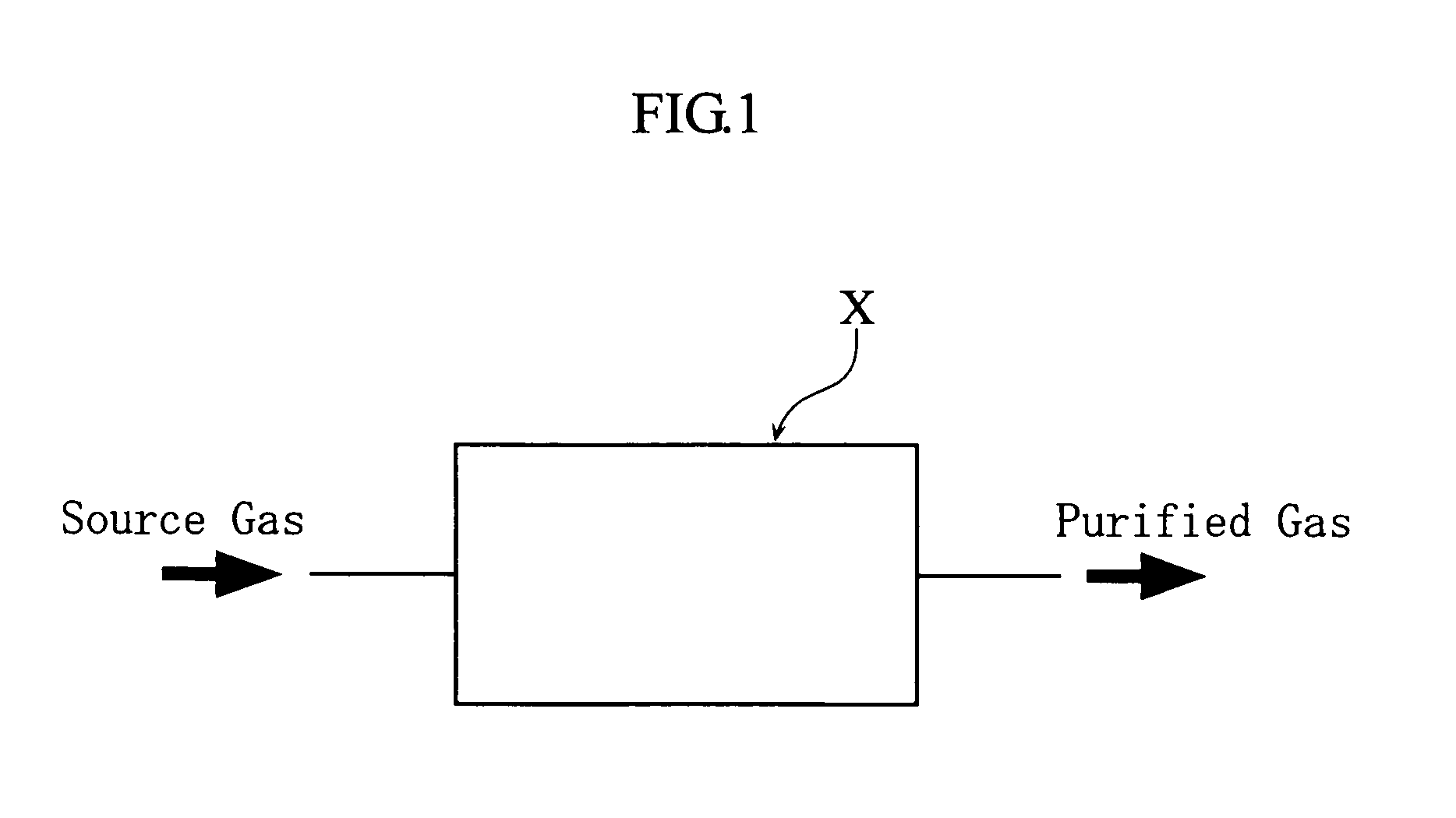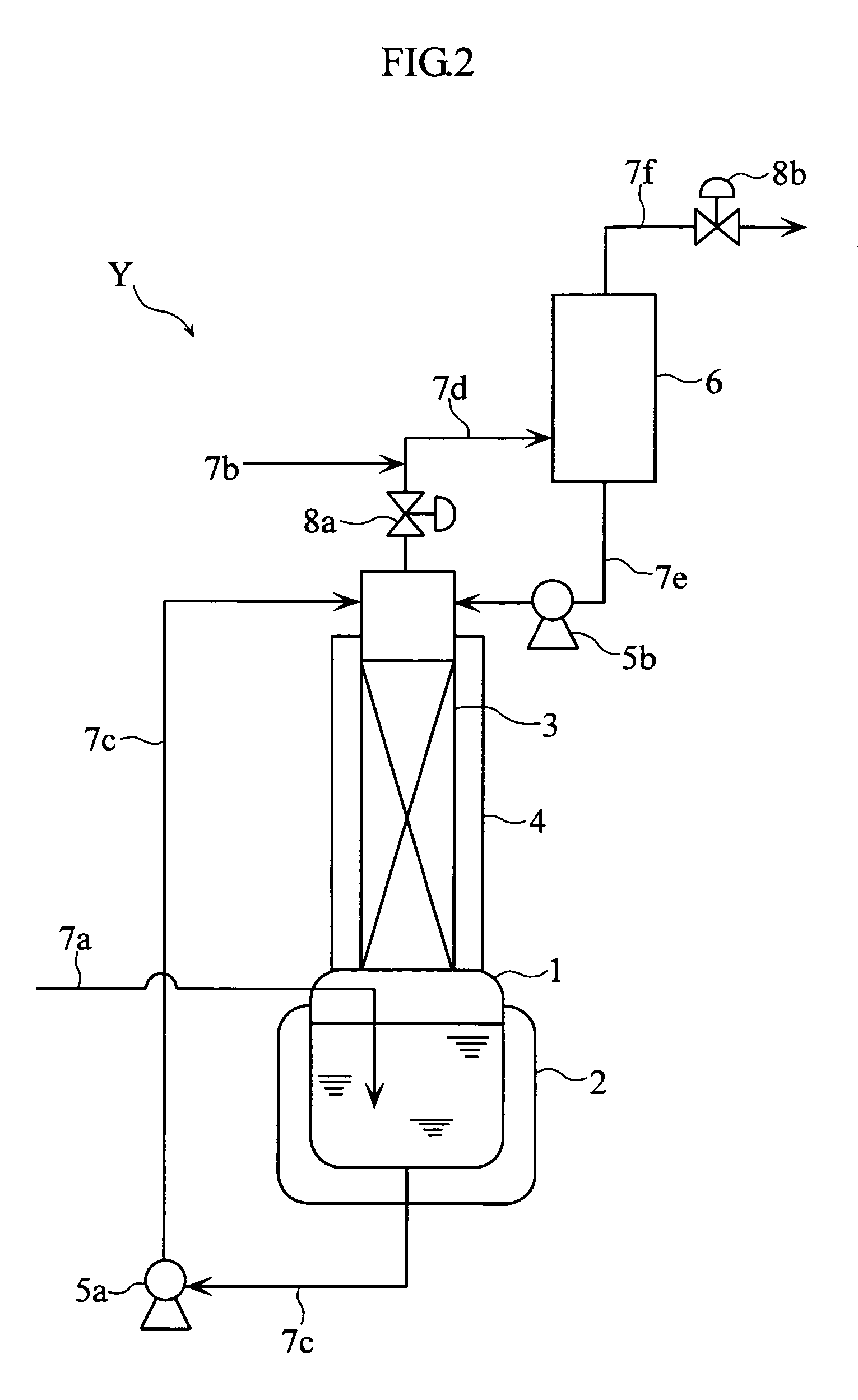Method for purification of nitrogen oxide and apparatus for purification of nitrogen oxide
a technology of nitrogen oxide and purification method, which is applied in the direction of nitrogen oxide/oxyacid, nitrous oxide, separation process, etc., can solve the problems of complex system containing nitrogen oxide, serious safety problems, and difficulty in executing ultra-low temperature steps, so as to achieve efficient purification of nitrogen oxide and high safety
- Summary
- Abstract
- Description
- Claims
- Application Information
AI Technical Summary
Benefits of technology
Problems solved by technology
Method used
Image
Examples
example 1
[0059]As the example 1, the NO purification method was executed with the condenser X shown in FIG. 1. In this example, a glass trap (500 cm3) cooled to −80° C. was employed as the condenser X, and raw NO gas containing 5000 ppm of NO2 as the source gas, and such source gas was supplied through the condenser X at a rate of 100 cm3 / minute (condensation-separation step). As a result, N2O3 and N2O4 generated from NO and NO2 in the source gas were condensed in the condenser X, and NO2 concentration in the purified NO gas led out of the condenser X was 80 ppm.
example 2
[0060]As the example 2, the N2O purification method was executed with the condenser X shown in FIG. 1. In this example, a glass trap (500 cm3) cooled to −80° C. was employed as the condenser X, and raw N2O gas containing 2000 ppm of NO as the source gas. In this example, firstly NO2 was added to the source gas to achieve a final concentration of 2000 ppm (concentration adjustment step). Then the source gas subjected to such concentration adjustment was supplied through the condenser X at a rate of 100 cm3 / minute (condensation-separation step). As a result, N2O3 and N2O4 generated from NO and NO2 in the source gas were condensed in the condenser X, and NO concentration in the purified N2O gas led out of the condenser X was 50 ppm, and NO2 concentration was 30 ppm.
example 3
[0061]As the example 3, the NO purification method was executed with the condenser Y1 shown in FIG. 3. In this example, a container (500 cm3) cooled to −10° C. was employed as the gas absorption vessel 1, a glass trap (500 cm3) cooled to −70° C. as the condenser 6, liquefied N2O4 (90 g) as the absorption solution, and raw NO gas containing 1000 ppm of N2 and 1000 ppm of N2O as the source gas.
[0062]In this example, the absorption step and the revaporization step in the gas absorption vessel 1, as well as the condensation-separation step in the condenser 6 were executed. In the absorption step, the liquefied N2O4 (90 g, −10° C.) was caused to absorb 32 g of source gas under normal pressure. In the revaporization step, the internal temperature in the gas absorption vessel 1 was gradually raised from −10° C. to 2° C. In the condensation-separation step, the gas evaporated in the revaporization step was supplied through the condenser 6, to produce condensed N2O3 and N2O4 gas generated fr...
PUM
| Property | Measurement | Unit |
|---|---|---|
| boiling point | aaaaa | aaaaa |
| boiling point | aaaaa | aaaaa |
| melting point | aaaaa | aaaaa |
Abstract
Description
Claims
Application Information
 Login to View More
Login to View More - R&D
- Intellectual Property
- Life Sciences
- Materials
- Tech Scout
- Unparalleled Data Quality
- Higher Quality Content
- 60% Fewer Hallucinations
Browse by: Latest US Patents, China's latest patents, Technical Efficacy Thesaurus, Application Domain, Technology Topic, Popular Technical Reports.
© 2025 PatSnap. All rights reserved.Legal|Privacy policy|Modern Slavery Act Transparency Statement|Sitemap|About US| Contact US: help@patsnap.com



